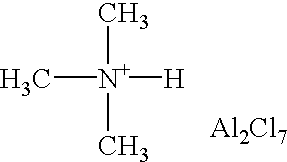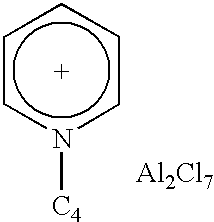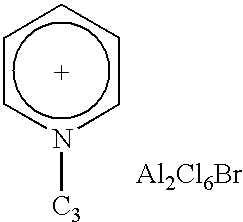Process of paraffin hydrocarbon isomerization catalysed by ionic liquids
a technology of paraffin hydrocarbons and liquids, applied in the field of catalytic isomerization of paraffin hydrocarbons, can solve the problems of ionization liquids, hydrogenolysis, cracking, etc., and achieve the effect of complicating technology and process design
- Summary
- Abstract
- Description
- Claims
- Application Information
AI Technical Summary
Benefits of technology
Problems solved by technology
Method used
Image
Examples
examples 2-10
[0041] The process of paraffin isomerisation is carried out at 5-40.degree. C. using ionic liquids prepared according to Example 1. The paraffin: ionic liquid weight ratio is equal to 1:1 or 1:1.5 at atmospheric pressure in the inert atmosphere (He), while stirring the mixture with a magnetic stirrer for 1-6 h. In this experiment, a 3-neck flask with a reflux condenser connected with a gas burette is purged with helium; then the hydrocarbon starting material and 5.0 g of ionic liquid catalyst (ammoniumchloride: AlCl.sub.3 molar ratio equal to 1:2) are loaded in the vessel and the reaction mixture is stirred for 5-6 h. The upper layer (the reaction products) is separated and analysed by gas chromatography. The experiments 5 and 6 were carried out in a stirred autoclave (stirring rate: 300 rpm) under nitrogen (1 bar in experiment 5 and 30 bar in experiment 6).
examples 11-12 (comparative)
[0042] The process of n-heptane isomerisation is carried out at 0 (Example 11) or 24.degree. C. (Example 12) as described using the conventional catalyst comprising CF.sub.3SO.sub.3H+SbF.sub.5 (33.0 wt %) supported onto fluorinated alumina (F content, 39.8 wt %). The results of testing are presented in the Table.
1TABLE Testing of catalysts based on ionic liquids In paraffin isomerisation Hydro- Performance carbon: Conditions iso- Hydro- catalyst T, Time, Conversion, Selectivity, Example Catalyst Title carbon ratio .degree. C. h % % 2 3 4 5 6 7 1 Trmethyl- amine hydrochlo-ride - aluminium chloride n-C.sub.7H.sub.16n-C.sub.7H.sub.163- Methyl-hexane n-C.sub.8H.sub.18n-C.sub.5H.sub.12n-C.sub.5H.sub.12 1:1.5 1:1 1:1 1:1 1:1 1:1 20 20 5 20 20 20 6 6 6 6 5 5 #50 42 84 42 24.4 26.6 100 97.4 99.8 97.5 92.2 96.2 8 2 N-Butyl-pyridinium chloride - aluminium chloride n-C.sub.7H.sub.16 1:1 30 1.5 41 100 9 3 N-Propyl- pyridinium- bromide - aluminum chloride n-C.sub.7H.sub.16 1:1 40 4 29 99.3 10 4 ...
PUM
| Property | Measurement | Unit |
|---|---|---|
| temperatures | aaaaa | aaaaa |
| octane number | aaaaa | aaaaa |
| octane number | aaaaa | aaaaa |
Abstract
Description
Claims
Application Information
 Login to View More
Login to View More - R&D
- Intellectual Property
- Life Sciences
- Materials
- Tech Scout
- Unparalleled Data Quality
- Higher Quality Content
- 60% Fewer Hallucinations
Browse by: Latest US Patents, China's latest patents, Technical Efficacy Thesaurus, Application Domain, Technology Topic, Popular Technical Reports.
© 2025 PatSnap. All rights reserved.Legal|Privacy policy|Modern Slavery Act Transparency Statement|Sitemap|About US| Contact US: help@patsnap.com



